Everybody knows there’s more to fries than white potatoes–but, swap in sweet potatoes, and achieving a solid crisp factor at home is a challenge. Is starch the secret? A good, long soak pre-bake? If you’ve ever wondered how to bake crispy sweet potato fries at home, this post is for you.

It starts with an Instagram message. My blog friend Katie wants to know how to bake crispy sweet potato fries and wonders if I have any tips. Making sweet potato fries, yes. Making crispy sweet potato fries? My standard method of slicing thin, tossing with coconut oil and roasting at high heat on a baking sheet is pretty hit or miss in terms of the crisp factor. So when she goes on to find success with a method I’ve never tried— soaking the sweet potatoes in cold water for an hour before roasting—I get curious.
What Makes a Good Sweet Potato Fry
In an ideal world, I’d make a sweet potato fry that’s crisp, stands on its own, doesn’t fall limp when I lift it from the pan—the kind of sweet potato fry restaurants serve, but without their standard deep-frying. In view of Katie’s discovery, I wonder if this may be more attainable than I think. I also wonder what other methods I’m missing.
How to Bake Crispy Sweet Potato Fries at Home
First, I turn to everybody’s favorite online food magazine, The Kitchn. In an article examining baked sweet potato fries, associate food editor Meghan Splawn says the secret’s in the starch.
“Take a gander at the ingredient lists of the many frozen sweet potato (and for that matter, plain ol’ potato) fries available in the grocery store and you’ll likely see a common ingredient: starch,” she points out.
Because of how it absorbs moisture from the sweet potatoes and cooks into a crisp crust, starch is a secret many home cooks swear by when they’re baking sweet potato fries. Splawn uses cornstarch, the most commonly available option, but recommends potato starch, which is what I buy. Blogger Laura Wright of The First Mess also vouches for arrowroot powder, a starch she “lean[s] on often to thicken mixtures” and another effective sub for cornstarch or cornmeal.
Good, I’m decided. One batch, I’ll test with soaking. The next, with starch.
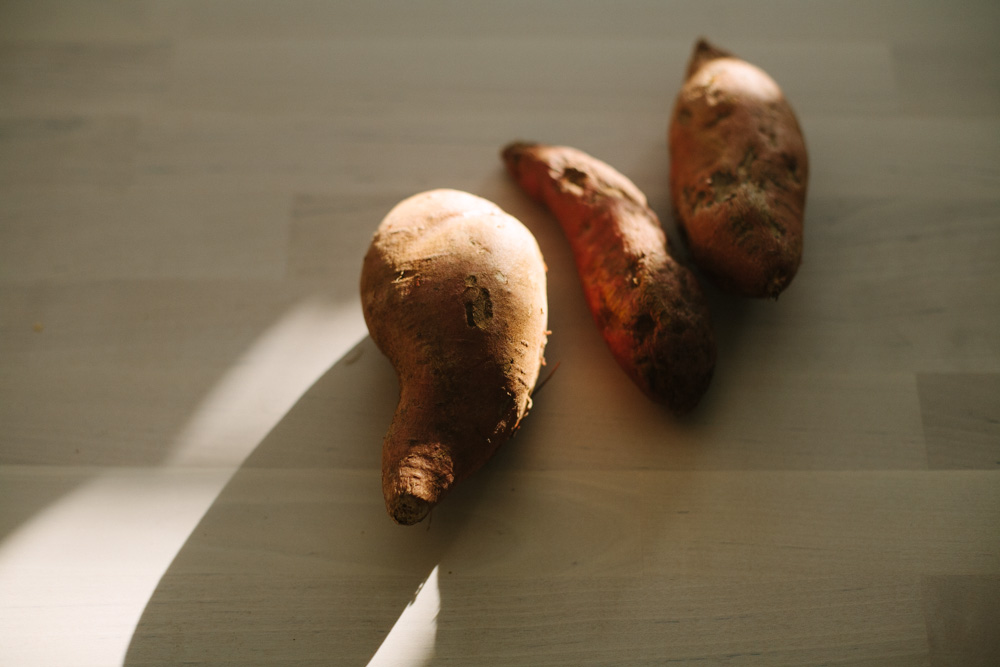
Testing Day 1
Monday morning, I slice two sweet potatoes into ¼-inch-thick matchsticks, placing one batch in a bowl of cold water and tossing the other with a tablespoon of starch. The soaked fries get strained, dried and tossed with two tablespoons of oil before roasting. The starched fries get tossed with two tablespoons of oil, too. Each batch goes onto a parchment-lined baking sheet, gets tossed once, bakes at 400°F and emerges intermittently crispy. The skinnier, almost burned fries hold up; the thicker, oily fries fall limp.

Good taste, but lack of crunch. Back to the drawing board.
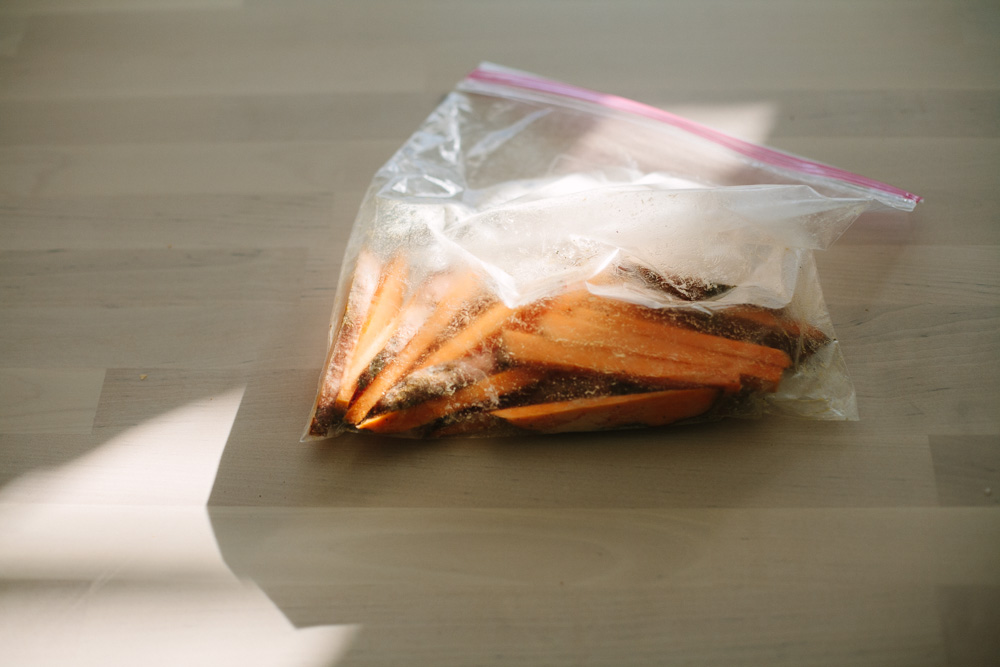
More Research
Wednesday afternoon, I approach the kitchen with new research. In the day since my first testing, I’ve read more articles, noted more recommendations and reached out to friends on Instagram, leading me to:
- Use less oil. Maybe neither of my first two methods were the problem; it could have been the oil. Turns out, two tablespoons of coconut oil per sweet potato is gratuitous. While deep-frying requires a large amount of oil to make fries crisp, roasting or baking relies on drier conditions to achieve sufficient crisp. In fact, multiple sources and people suggest too much oil equals soggy fries. Today’s plan: go minimal with the oil, say one teaspoon per potato.
- Use higher heat. Multiple recipes suggest upping the oven temperature to at least 425°F, if not 450°F at the end. Higher heat achieves more of a roasting effect, potentially helping the fries crisp. Today’s plan: test the fries at a higher baking temperature, as well as with less oil.
- Use lower heat—and a baking rack. When I first read an Instagram message that says to cook the fries on a wire rack, I think it’s a typo. Aren’t wire racks just for cooling cookies? According to Epicurious, no. Of the many other tasks oven-safe baking racks can achieve, creating crispier baked goods is one of them. “Using a cooling rack to suspend breaded foods as they bake with significantly up the crunch factor,” says editorial assistant Tommy Werner in “Why Your Cooling Rack Is the Hottest Kitchen Tool.” The rack allows hot air to circulate evenly around the fries. Today’s plan: test the fries at 350°F°F for about an hour, set on a baking rack on a baking sheet.

Testing Day 2
Today, both methods yield success. For the first batch, I soak, starch and massage sweet potato wedges (two days later, I try matchsticks, with the same results) with a teaspoon of coconut oil. The pan goes into the oven for 35 minutes at 425°F. Results: this method yields crisp, caramelized fries, with a little charring on the edges.
For the second batch, I massage the wedges with a teaspoon of coconut oil and spices, set them on a wire rack in a baking pan and place that pan in the oven at 350°F for an hour. Results: These fries are even more surprising, crisp outside, soft inside and delightfully lined with grill marks.
Crispy sweet potato fry success.
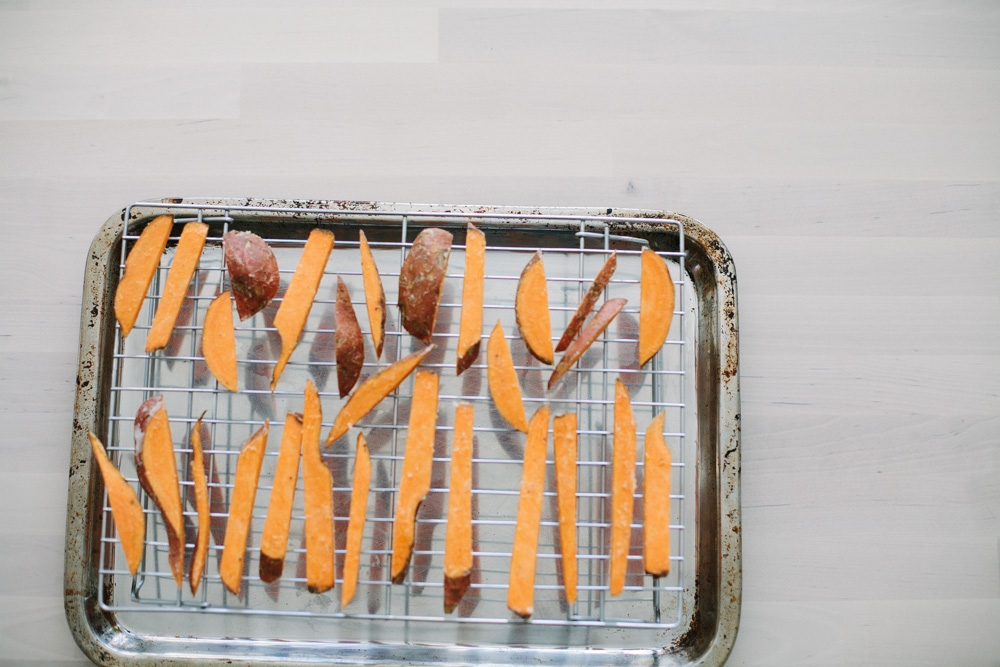
Two Good Options for How to Bake Crispy Sweet Potato Fries
Slice a sweet potato into roughly the same-sized fries, whether that means wedges or 1/4-inch sticks. The more similar their sizes, the more evenly they’ll bake. This is tough with odd-shaped sweet potatoes, so no pressure for perfection here. To make sweet potatoes for a crowd, multiply the recipe–and, if you’re using option two, be sure to have a second wire rack.
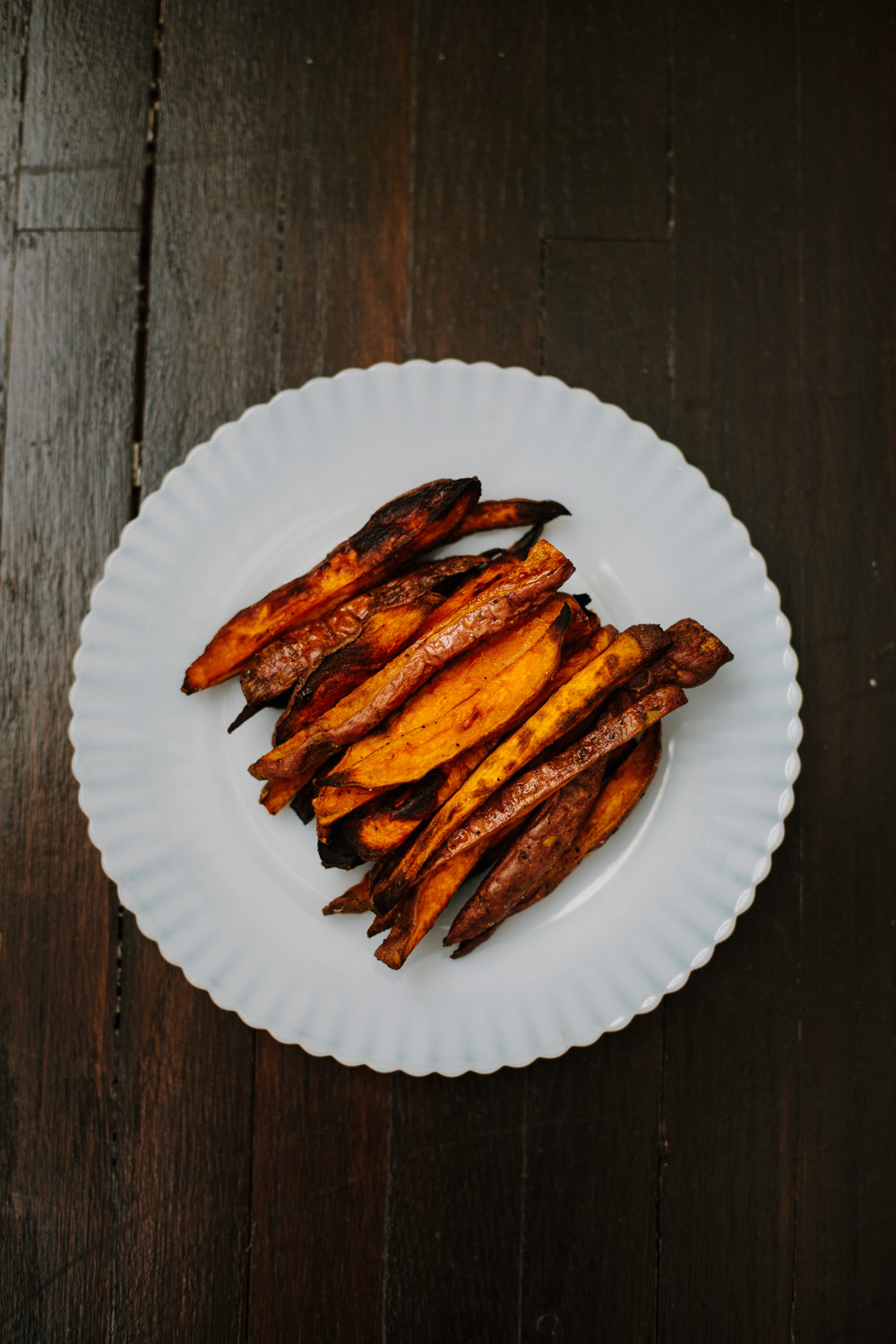
Option #1: High Heat, 35 Minutes
Soak your sweet potato pieces in cold water for an hour. In either a ziplock bag or a bowl, toss them with a teaspoon of starch until well-coated*. Next, in the same bag or bowl, toss with a teaspoon of oil, with spices if desired. Make sure the oil is liquid, i.e., if you’re using coconut oil, massage it with your hands to desolidify. Spread pieces out on a parchment-lined baking sheet in a single row. Bake at 425°F for 35 minutes. If you haven’t already added seasonings, add them at this point.
*If you skip the soak and starch, you will still achieve a fair amount of crisp factor with this recipe, so feel free to oil up your potatoes and proceed.
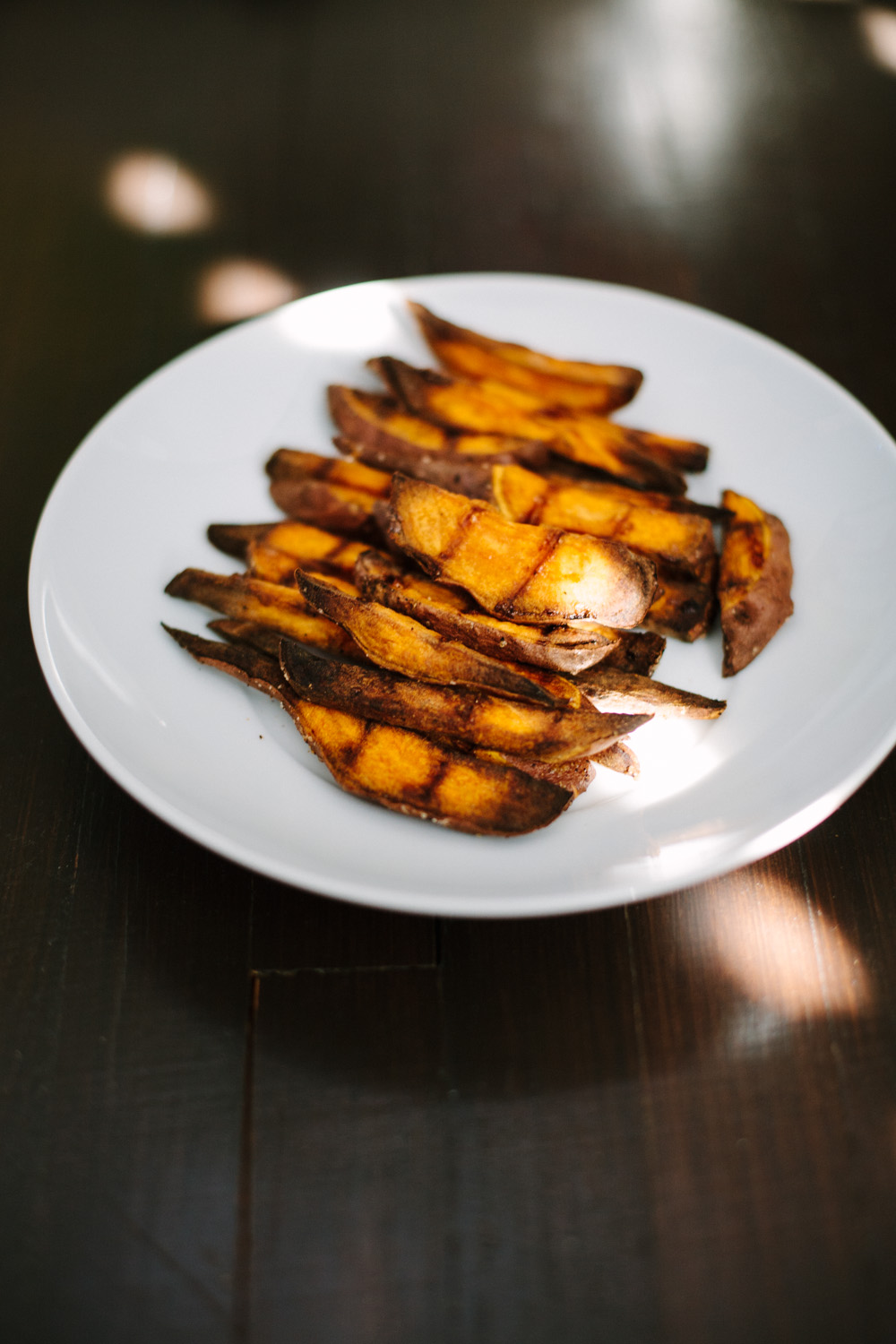
Option #2: Low Heat, Wire Rack, 1 Hour
Toss your fries with a teaspoon of oil, with spices if desired. Make sure the oil is liquid, i.e., if you’re using coconut oil, massage it with your hands to desolidify. Set a wire baking rack in a rimmed baking sheet and spread out your sweet potato fries in an even layer. Bake these fries low and slow, at 350F for about an 45 minutes to an hour. If you haven’t already added seasonings, add them at this point.
Conclusions
The Internet is a tornado of advice about sweet potato fries–making them, getting them crispy, etc.–but there are two key conclusions you can count on:
- Don’t use too much oil. The biggest discovery I made in this experiment was the one I never expected to be a factor: I was using too much coconut oil. As a home cook who tends to “add a little oil” when I roast, I had been unknowingly overdosing. Too much oil made my fries soggy and limp, not to mention occasionally greasy. Life lesson, one teaspoon to one potato is plenty.
- Drier is better for crisp factor. What both of the winning methods had in common was the ability to dry the fries out as they cooked. Soaking in water and tossing with starch gave me negligible differences when I used the right amount of oil, but the reason those methods have high success rates is that they’re pulling out moisture from the sweet potatoes. Life lesson, dry out your sweet potatoes to get them crisp.
So, after one week of testing and a full bag of sweet potatoes: victory. And the next time someone wants to know how to bake crispy sweet potato fries, I’ll know what to say: achieving restaurant-style results at home is doable, and here are two ways to try.
This post on how to bake crispy sweet potato fries is third in a series of articles examining kitchen questions. Also in this series are a comparison of pie crust ratios and a look at smoothie packs.
